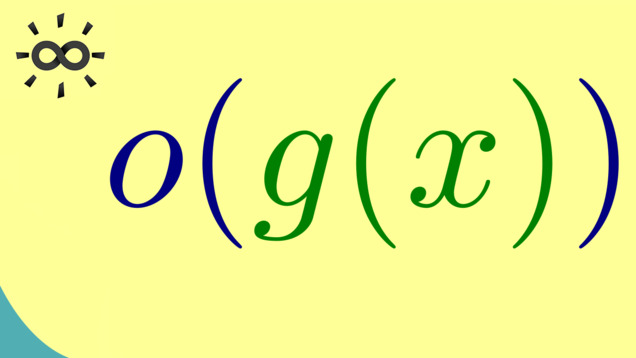
-
Title: Little o
-
Series: Advent of Mathematical Symbols
-
YouTube-Title: Little o
-
Bright video: https://youtu.be/dzBsw96VtQ4
-
Dark video: https://youtu.be/uzCiY5QgsVw
-
Ad-free video: Watch Vimeo video
-
Quiz: Test your knowledge
-
Dark-PDF: Download PDF version of the dark video
-
Print-PDF: Download printable PDF version
-
Thumbnail (bright): Download PNG
-
Thumbnail (dark): Download PNG
-
Subtitle on GitHub: aoms17_sub_eng.srt
-
Timestamps (n/a)
-
Subtitle in English
1 00:00:00,629 –> 00:00:02,200 Hello and welcome.
2 00:00:02,372 –> 00:00:05,314 The mathematical symbol of today is little o.
3 00:00:05,543 –> 00:00:07,519 Denoted with a small o.
4 00:00:08,514 –> 00:00:14,801 If you know the big O notation, you will not be surprised that we also find parentheses next to the little o.
5 00:00:15,001 –> 00:00:17,329 and also a function inside.
6 00:00:17,796 –> 00:00:20,879 So this is little o of g(x).
7 00:00:21,800 –> 00:00:25,414 However this symbol only makes sense with respect to a limit.
8 00:00:25,786 –> 00:00:29,119 So we would write x goes to a number “a”.
9 00:00:29,857 –> 00:00:35,429 In fact “a” could be a real number or the symbol infinity or - infinity.
10 00:00:36,214 –> 00:00:41,898 Now in this little o notation we usually use an equality sign in a symbolic way.
11 00:00:42,743 –> 00:00:48,555 So we would say another function f(x) is equal to little o of g(x).
12 00:00:49,357 –> 00:00:55,332 However as for the big O notation an element relation here would be the formal correct way.
13 00:00:56,029 –> 00:00:58,785 Nevertheless of course this is not so important.
14 00:00:58,814 –> 00:01:02,343 The important thing is that you know the meaning of this expression here.
15 00:01:03,343 –> 00:01:12,186 In fact this little o here should tell you that the function g grows much faster than the function f, when x goes to “a”.
16 00:01:13,271 –> 00:01:17,343 and this property can be expressed with a limit process.
17 00:01:17,439 –> 00:01:20,342 So we have limit x goes to “a”.
18 00:01:21,214 –> 00:01:25,252 and then we simply consider the ratio of f to g.
19 00:01:26,171 –> 00:01:31,742 Now usually for consistency reasons one takes the absolute value of this ratio.
20 00:01:32,871 –> 00:01:36,613 and then finally in the limit this should go to 0.
21 00:01:37,600 –> 00:01:44,843 So you see this equality tells us that the function g dominates the function f in this limit process.
22 00:01:45,929 –> 00:01:49,310 Ok, then i think it’s helpful to look at an example here.
23 00:01:50,457 –> 00:01:53,686 Here lets consider the function 8 times x squared.
24 00:01:54,929 –> 00:01:59,090 and the limit process we are interested in should be x goes to infinity.
25 00:02:00,214 –> 00:02:03,958 and now the function g should be just x squared.
26 00:02:04,786 –> 00:02:09,967 So here you should see we do not have that the limit on the left hand side goes to 0.
27 00:02:10,929 –> 00:02:16,022 So this function is not of little o(x^2), when x goes to infinity.
28 00:02:16,943 –> 00:02:22,654 However if we consider little o of x cubed, we have that the limit goes to 0.
29 00:02:23,643 –> 00:02:28,652 So we can say this function 8 times x^2 is little o(x^3).
30 00:02:29,743 –> 00:02:34,360 Ok, then i hope that this was helpful and that i can see you in the next video.
31 00:02:34,560 –> 00:02:35,193 Bye!
-
Quiz Content
Q1: Which of the following functions is $o(x^2)$?
A1: One needs more information.
A2: $f(x) = 4 x^2 - x$
A3: $f(x) = \exp(x)$
A4: $f(x) = 5 x^3 - 1$
A5: $f(x) = \sin(x)$
Q2: Which of the following functions is not in $o(x^3)$ with $(x \rightarrow \infty)$?
A1: One need more information.
A2: $f(x) = 4 x^2 - x$
A3: $f(x) = 5 x^3 - 1$
A4: $f(x) = \sin(x)$
-
Last update: 2024-11